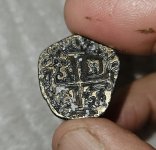suprdave
Sr. Member
- Aug 3, 2010
- 342
- 25
- Detector(s) used
- Whites XLT
- Primary Interest:
- All Treasure Hunting
found a half with 2 edges clipped from it. could this be considered a mistrike. i know that on a dime it is considered a double clip coin. any info would be appreciated. suprdave ps no picture as of yet.




